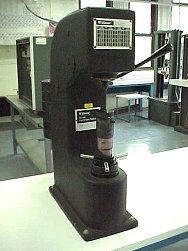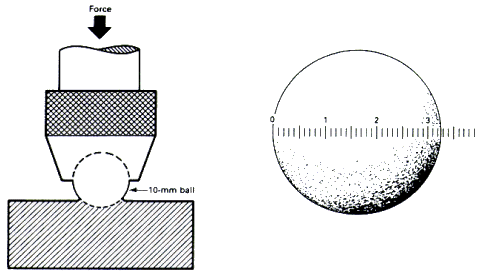The Brinell test involves applying a constant load (usually 500 to 3000 kg) through a spherical hardened steel penetrator (5 or 10 mm in diameter) until plastic deformation ceases (10 to 30 seconds). The test should be performed on a flat surface. The diameter of the permanent indentation is then measured and the hardness number (HB - Hardness Brinell) determined from the equation:
where P is the load (in kilograms), D is the penetrator diameter in mm, and d is the indentation diameter in mm. Calculation of hardness number is usually avoided by referring to a chart, supplied by the testing machine manufacture, relating indentation diameter (d) to hardness number (HB) for a given load and penetrator diameter.
The Brinell Hardness number is load divided by the curved surface area of the indentation. The rather odd units are kilograms per square millimeter, but they are not generally carried with the numerical value.
Standard loads used in the Brinell test are 500, 1000, 1500, 2000, 2500 and 3000 kg. The 500 kg load is most commonly used for soft metals while the 3000 kg load is generally used for testing harder materials such as steel. A 10 mm diameter penetrator is generally used. After the load is applied for a specified time (usually 10 to 15 s for hard, ferrous materials and about 30 s for soft, nonferrous materials), the recovered indentation diameter is measured in millimeters. This time period is required to ensure that plastic flow of the work metal has ceased.
Tables for 500 kg load on:The Brinell hardness number is approximately proportional to tensile strength. It has been found that for ordinary steels the tensile strength in psi is approximately 500 times the Brinell hardness number:


